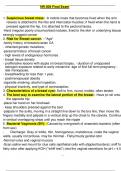NR 509 Final Exam
1. Suspicious breast mass: -A mobile mass that becomes fixed when the arm
relaxes is attached to the ribs and intercostal muscles; if fixed when the hand is
pressed against the hip, it is attached to the pectoral fascia.
-Hard irregular poorly circumscribed nodules, fixed to the skin or underlying tissues
strongly suggest cancer
2. Risk for Breast cancer: --*Age*
-family history of breast/ovarian CA
- inherited genetic mutations,
-personal history of breast cancer
- high levels of endogenous hormones
- breast tissue density
- proliferative lesions with atypia on breast biopsy, - duration of unopposed
estrogen exposure related to early menarche -age of first full-term pregnancy -
late menopause.
- breastfeeding for less than 1 year,
- postmenopausal obesity
-cigarette smoking, alcohol ingestion,
- physical inactivity, and type of contraception.
3. Characteristics of a breast cyst: Soft to firm, round, mobile, often tender.
4. The best way to examine the lateral portion of the breast: -Have pt roll onto
the opposite hip
-place her hand on her forehead.
- keep shoulders pressed against the bed
-palpate in the axilla, moving in a straight line down to the bra line, then move the
fingers medially and palpate in a vertical strip up the chest to the clavicle. Continue
in vertical overlapping strips until you reach the nipple
5. Bacterial Vaginosis (BV): -Caused by overgrowth of anaerobic bacteria (often
from sex)
- Discharge: Gray or white, thin, homogenous, malodorous, coats the vaginal
walls, usually not profuse, may be minimal - Fishy/musty genital odor
-Normal vulva and vaginal mucosa
-Scan saline wet mount for clue cells (epithelial cells with stippled borders); sniff fo
fishy odor after applying KOH ("whiff test"); test the vaginal secretions for pH > 4.5
1/9
, NR 509 Final Exam
6. Candidal Vaginitis: -Cause: Candida albicans, a yeast (normal overgrowth of
vaginal flora); many factors predispose, including antibiotic therapy
-Discharge: white and curdy, may be thin but usually thick, not as profuse as
trichomonal infection, not malodorous
- vaginal soreness, pruritus, pain on urination, dyspareunia (painful intercourse
-The vulva and surrounding skin are inflamed and sometimes swollen to a variable
extent; the vaginal mucosa is reddened, with white tenacious patches of discharge
the mucosa may bleed when these patches are scraped off; in mild cases, the
mucosa looks normal
-Scan potassium hydroxide (KOH) preparation for the branching hyphae of Candida
7. Trichomonal Vaginitis: -Trichomonas vaginalis, a protozoan; often but not
always acquired sexually
- Discharge:Yellowish green or gray, possibly frothy; often profuse and pooled
in the vaginal fornix; may be malodorous
-Pruritus (though not usually as severe as with Candida
infection); pain on urination (from skin inflammation or possibly urethritis);
dyspareunia
-Vestibule and labia minora may be erythematous; the vaginal mucosa may be
diffusely reddened, with small red granular spots or petechiae in the posterior fornix;
in mild cases, the mucosa looks normal - Scan saline wet mount for trichomonads
8. Syphillis: This ulcerated papule with an indurated edge usually appears after 3
to 6 weeks of incubating infection from the spirochete Treponema pallidum.
These lesions may resemble a carcinoma or crusted cold sore. Similar primary
lesions are common in the pharynx, anus, and vagina but may escape
detection since they are painless, nonsuppurative, and usually heal
spontaneously in 3 to 6 weeks. Wear gloves during palpation since these
chancres are infectious.
9. s/s of epididymitis: Acute: swollen, and notably tender, making it difficult to
distinguish from the testis. The scrotum may be reddened and the vas deferens
inflamed.
Chronic: firm enlargement of the epididymis, which is sometimes tender, with
thickening or beading of the vas deferens.
2/9




